Heritage: What Is Ganesh Doing in Buddhist Thailand?
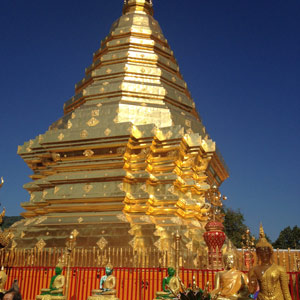
A leisurely trip turns into a studied discovery of the fascinating crossroads of Buddhism and Hinduism in Southeast Asia and reveals interesting insights into how cultures migrate and evolve.
(Left) Stupa at Doi Suthep.
The 600-year-old shrine of Wat Phra That Doi Suthep, a Theravada wat (temple) in Chiang Mai, a city in the mountainous northern region of Thailand, has many large and small statues of Buddha, beautifully crafted out of semiprecious materials like jade, emerald, and other stones. The stupas are coated with gold leaf.
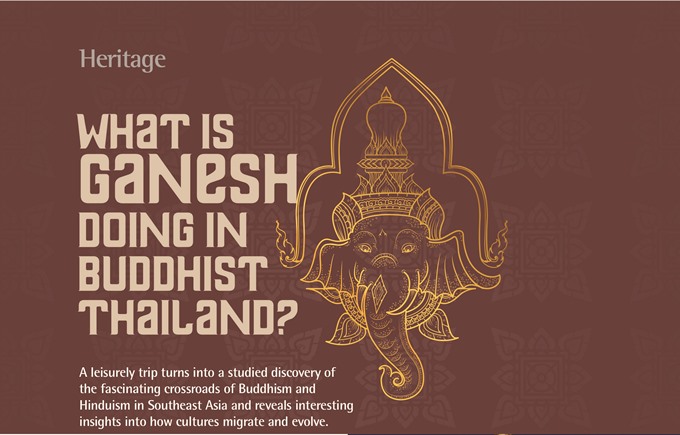
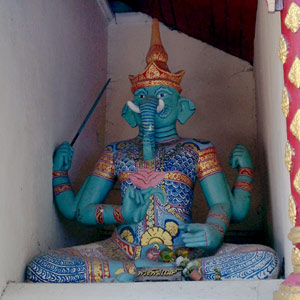
(Right) The slim Ganesha at Doi Suthep.
Amidst this rich Buddhist imagery, I came across a rather slim sculpture of Lord Ganesh, blue-green in color, seated erect, wearing a Thai-style crown. Unlike the typical Indian Ganesh, with a pot-belly and a kind look on his face, this version appeared more like a king.
What was Lord Ganesh doing in Thailand, the land of Buddhism, I wondered. My guide informed me that Thai people worshipped Ganesh to grant them inner harmony and peace. The Thais, I was told, pray to Buddha for a good next life, and Ganesh for inner peace in the present life. Even in India—where Hinduism and Buddhism originated—there is no close association between these two religions other than the fact that Hinduism, in its effort to absorb Buddhism, declared Buddha as the ninth incarnation of Vishnu.
Chiang Mai, where I came across the aforementioned Lord Ganesh sculpture, was our first stop in Thailand. My wife and I were travelling across Thailand, Laos, and Cambodia. Our travel agent, aware of our interest in art, history, and culture, generously included stops at many grand old temples which are prolifically scattered throughout these lands.
Worship has been at the core of every ancient civilization, from Greek to Egyptian, Roman, Mayan, Hindu, Christian, and Muslim. Not surprising, then, that some of the most spectacular structures across the world are places of worship. These structures, besides housing sacred deities or reflecting specific beliefs, were also representative of the life people led in the era when they were built. The grandeur and size of these marvelous monuments were indicative of the enormous amount of time, effort, and wealth spent by worshippers in building these divine edifices.
Many of these ancient temples are still active places of worship. However, some are mere ruins, and tell a tale of humanity’s glorious past—much as how temples, monasteries, and monuments across Southeast Asia indicate the influence both Hinduism and Buddhism had over people in the region.
And so, for me, a published author on Indic thought systems, what began essentially as a pleasure trip, soon transformed into an intense cultural discovery as we continued to see the same intriguing amalgamation of these two great religions in motifs, sculptures, temples, and wats throughout our trip.
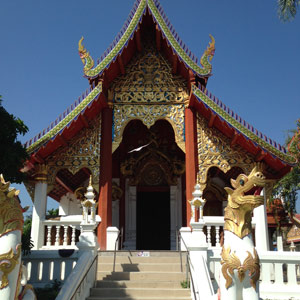
(Left) A neighborhood temple in Chiang Mai, Thailand.
The neighborhood of the hotel we stayed in was dappled with many wats. Their unique roof structures, unusual color combinations of gold with red, green, or blue, and embedded cut-glass façade, attracted us. Inside, we encountered a statue of Buddha, a meditation room, and a stupa or chedi in the courtyard, just outside the chapel.
A stroll in the market around the hotel further revealed Hinduism’s influence on Thailand. I was surprised to see many paintings and statues of Lord Ganesh, despite the fact that Hindus are a minority in Thailand.
Patterns of Buddhist-Hindu amalgamation emerge across most of Southeast Asia
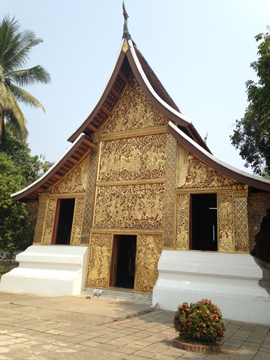
(Right) The scene of Ravan fighting with Jatayu (in the triangular panel on the top right corner of the front façade) of Wat Xieng Thong in Luang Prabang.
• In Luang Prabang, the ancient capital of the Luang Prabang province in northern Laos, while the inner sanctums of temples narrate stories about Buddha’s life in paintings, the exterior is usually adorned with scenes from the Ramayana, painted or carved onto walls or doors.
• The front façade of a 600-year-old temple has a panel depicting Ravan fighting with Jatayu, who tries to stop him from kidnapping Sita.
• Yet another old Buddhist shrine has colorful statues of Hanuman and Ravan standing on each side of the entrance. Even more surprising was the fact that people had worshipped both with floral offerings, revealing that in this part of the world, Ravan is not considered evil. The reasons could vary: some may believe that both good and evil balance each other, while for some, the fact that Ravana was a great devotee of Lord Shiva makes him worthy of worship.
• Siem Reap in Cambodia, one of our destinations, is known for the stunning UNESCO heritage site of Angkor Wat, one of the largest religious monuments in the world. Almost 1.7 km north of the entrance to Angkor Wat, is the Angkor Thom complex of temples, with a south entrance that showcases four weather-beaten magnificent faces of Buddha, carved in the 12th century, which represent attributes such as sympathy, charity, compassion, and loving kindness. Perhaps, the secret of personal growth and emancipation lies captured in these four faces.
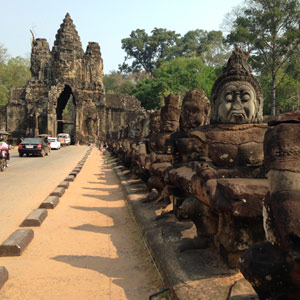
(Left) The “Churning of the Sea” myth depicted at Angkor Thom. On the left of the causeway are the devas (pictured below), and on the right of the causeway are the asuras (pictured at left).
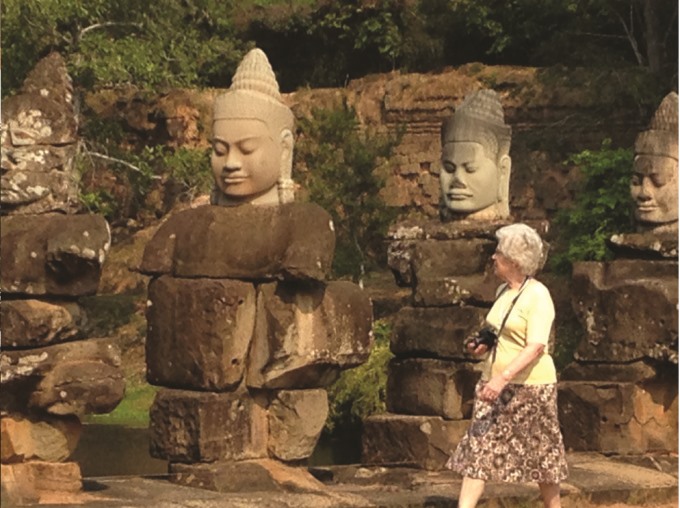
The causeway crossing the moat on the way to the temple is lined on both sides with what seem like massive serpent figures, similar to the serpent statues guarding temples in Chiang Mai and Luang Prabang. A closer look, however, reveals that these figures are actually a sculptural retelling of the Hindu myth of ‘Churning of the Sea’ in which devas (gods) and asuras (demons) used the serpent Vasuki to churn the sea of milk for extracting elixir, which would make them immortal. The stone sculptures of devas, with calm and serene faces, are lined up on the left side of the gate, while the demons, with contorted faces that display strife and aggression, are on the right. The sculptures could be indicative of how one has to traverse a world full of evil and divine, before becoming Buddha ourselves.
• The “churning of the sea of milk” myth isn’t just represented in different ways at Angkor Thom and Angkor Wat, but also on several modern buildings and carved on wood panels across the province.
• In Thai iconography, too, we see the same myth appear. At the Suvarnabhumi International Airport in Bangkok, there is a beautiful, large construct of the gods and demons churning the sea right behind the customs and security clearance in the departure lounge.
• The fascination in Southeast Asia for Mount Meru, from the Hindu mythology, is due to their belief that it is the abode of god and of higher souls. A number of kings, at least from the Angkorean civilization, to house their sarcophagi, built mountain temples, surrounded by lakes, imitating the image of Mount Meru.
How did the Khmers and Thais take to
Indian Religions?
My curiosity about how the two great religions came to coexist had peaked by now, raising several questions. Who are these people who call themselves Khmer (in modern Cambodia) or Thai, but are influenced by Hinduism? When and how did Indian beliefs come to be this part of the world? India had never invaded these countries, so how did the people here become familiar with stories from the Ramayana (which is called ‘Ramakien’ in Thailand)?
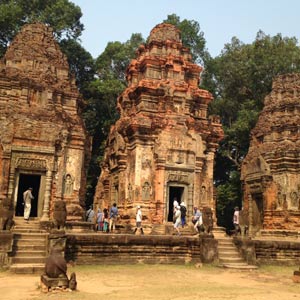
(Left) The presence of Shaivism in Cambodia: Preah Ko temples in brick (9th century), with Nandi bull sitting in front of them.
So I began looking for reliable sources of information. The answer could lie in the trade relations India shared with the rest of Southeast Asia. According to Upinder Singh’s book, A History of Ancient and Early Medieval India: From the Stone Age to the 12th Century, these ties could date back to 500-400 BCE. According to her, during the Chola reign in South India, which partially overlapped with the Angkorean period (9th-15th centuries) in Southeast Asia, there were stronger ties between the two regions, and possibly even “…traders (from India) were accompanied by soldiers.”
But can exposure to an outside culture only through travel and trade influence people on such a large scale? The ruling elite must have seen something in these beliefs which prompted them to adopt religious practices and erect these temples devoted to Shiva, Vishnu and Buddha. David Chandler, writing in A History of Cambodia (Fourth Edition), says that these beliefs and practices have existed since pre-Angkorean kings in Cambodia. A cult worshipping Shiva was known to exist in the 5th century, even as Buddhism and Vaishnavism flourished between 3rd and 6th centuries.
The royal patrons
King Jayavarman VII began work on Angkor Thom, one of the largest Khmer cities, in the 12th century, and his successors carried on with the construction. The walls, hallways, galleries and arches, statues and inscriptions across Angkor Thom and Angkor Wat are art canvases for scenes from the Ramayana, Mahabharata, and other Hindu mythologies, also depicting apsaras, nagas, and Buddha himself, as well as scenes from the daily life of Cambodian people.
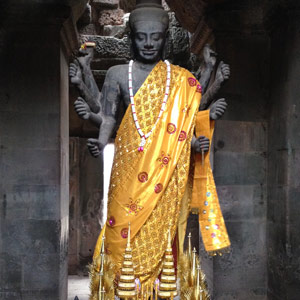
(Left) Lord Vishnu at Angkor Wat.
While the principal image in Bayon temple at Angkor Thom is that of Buddha, and the temple has 37 towers depicting Buddha faces, one of the chambers has a Shiva lingam. Likewise, in Baphoun temple, believed to be originally a Hindu temple dedicated to Shiva, there is an incomplete reclining Buddha sculpture. The Theravada Buddhists consider Angkor Wat as their pilgrimage site; but it was originally a Vishnu temple built under Suryavarman II.
Such blending of beliefs tells a two-sided story. While it depicts tolerance for different belief systems, it also suggests conflicts between them. The kings who built these monuments believed in different religions. Though their names ended with the same suffix “varman” (means ‘protected by’) they were not all related. So, while Jayavarman VII was a Mahayana Buddhist who built Bayon, his successor, Jayavarman VIII followed Hinduism and apparently had an existing statue of Buddha thrown into the central well of the temple. Michael Freeman and Claude Jacques, point out in their book Ancient Angkor, that the statute was recovered in multiple pieces during restoration. Similarly, say these authors, the beautiful statue of eight-armed Vishnu is sitting in a different place than the central sanctuary, where it was possibly installed originally.
Chandler, in A History of Cambodia, claims that in order to maintain harmony among diverse religions, the society of that time conceived of deities such as Harihara, by combining the attributes of Vishnu (Hari) and Shiva (Hara).
The temples, then, besides telling a fascinating story of a great past, are also suggestive of how different belief systems coexisted—sometimes by collaborating, and at other times by fighting for prominence. Apparently, destruction of temples was not uncommon. A History of Cambodia talks about inscriptions in Khmer that admonish against neglecting, robbing, or destroying temples. Invading armies may also have destroyed these temples. Hundreds of beheaded statues of Buddha in Siem Reap, as well as in Ayutthaya, the old capital of Thailand, suggest that anti-Buddhist armies destroyed them.
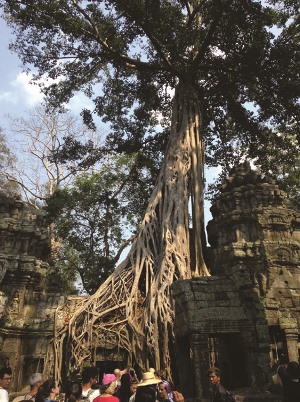
(Left) A massive tree growing on top of a temple at Ta Prohm. A number of countries, including India, are supporting crucial restoration projects.
Restoring these crucibles of culture
Ironically, while these temples represent cultures that are timeless, they are themselves victims of natural and manmade disasters, much like the civilizations that built them. Besides being subjected to human whims and rage, ancient monuments and temples have faced the wrath of nature. Monuments have been destroyed by heat, dust, rain, and forests that grow on and around them in areas that humans haven’t inhabited for long periods. There are temples with massive trees growing on top. To preserve the history, art, and rich cultures and civilizations that they represent, it is imperative that they are restored to a semblance of their former glory, and it is heartening to see that a number of countries, including India, are supporting some of these crucial restoration projects.
Meanwhile, even in their dilapidated form, these temples seem alive, they attract millions of locals and tourists and inspire awe in their beholder’s mind. For me, this was not only a journey into time and temples, but also a fascinating study of how and why India’s religious footprint extended into what were distant lands in those days.
Jaidev Dasgupta, PhD, is the author of In Search of Immortality: An Introduction to Indic World-Views (New Delhi, India: Manohar, 2015). He is deeply interested in Indic thought systems and their relevance in the modern context. He has been a scientist (MS in Physics, PhD in Biology), technologist, and entrepreneur.
Enjoyed reading Khabar magazine? Subscribe to Khabar and get a full digital copy of this Indian-American community magazine.
blog comments powered by Disqus










